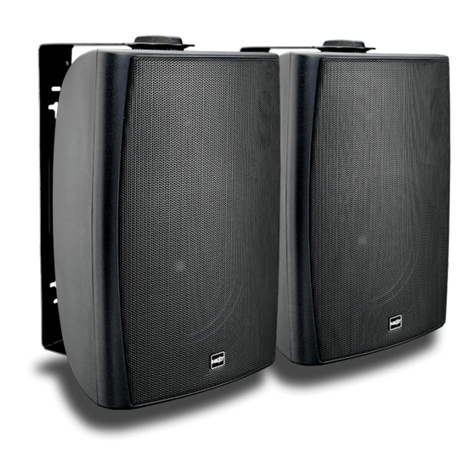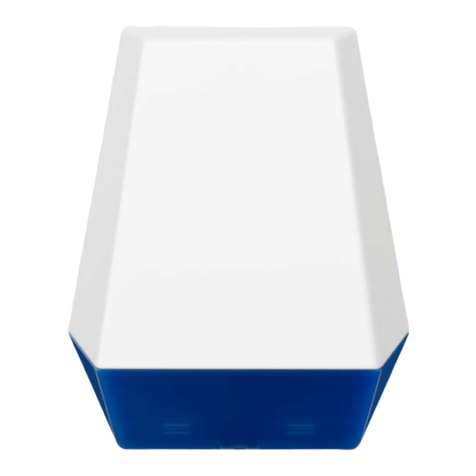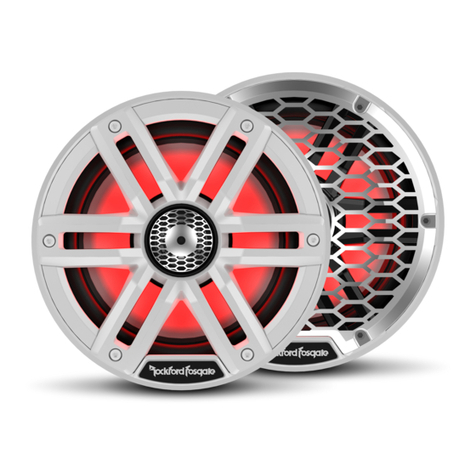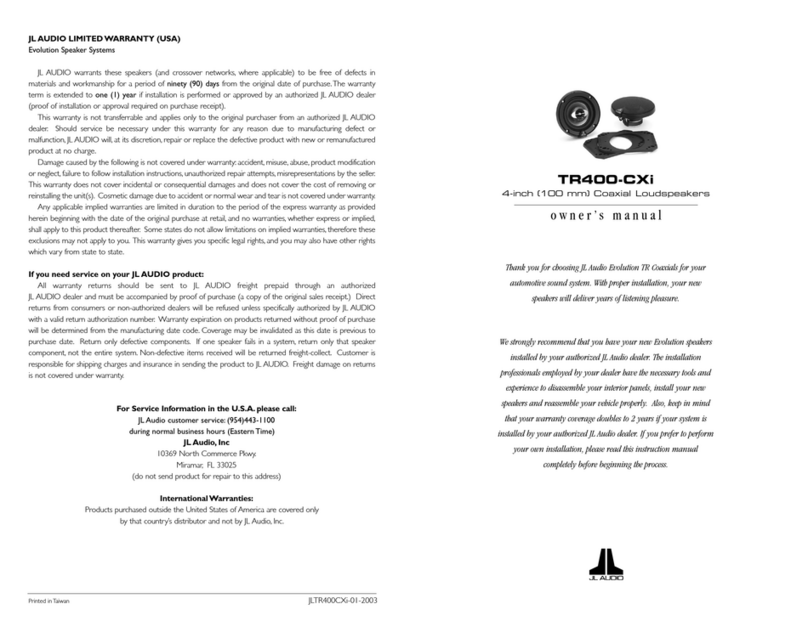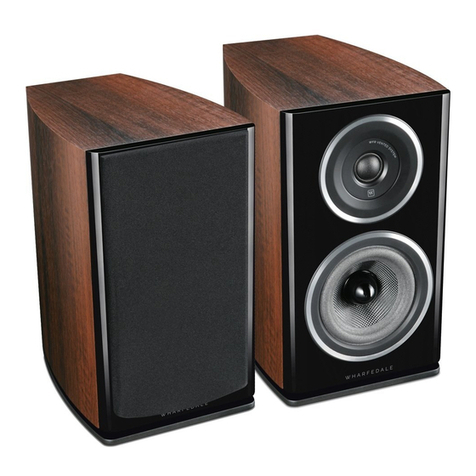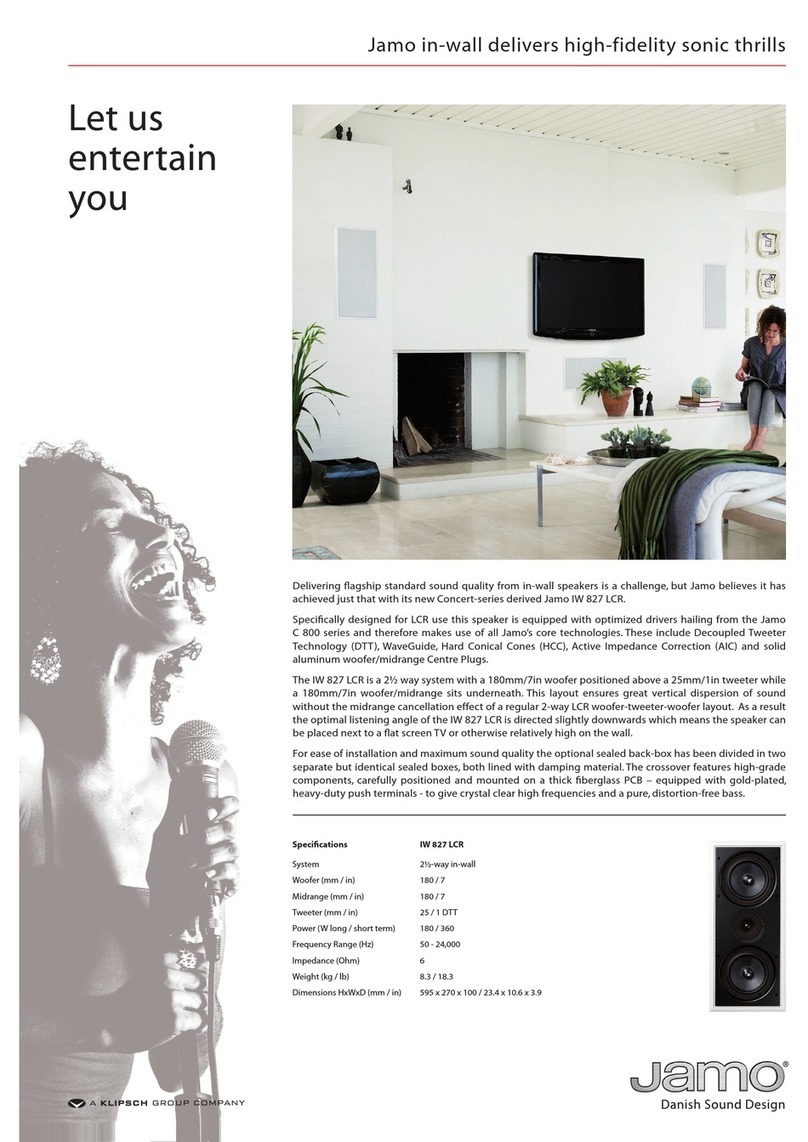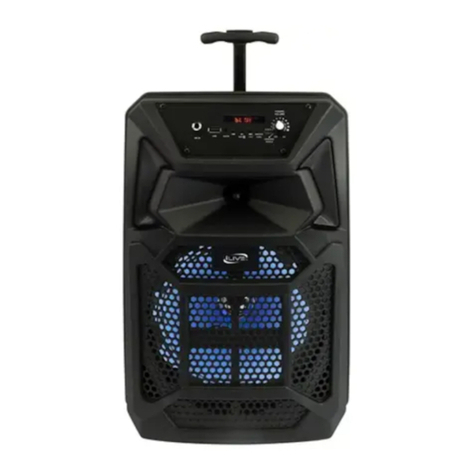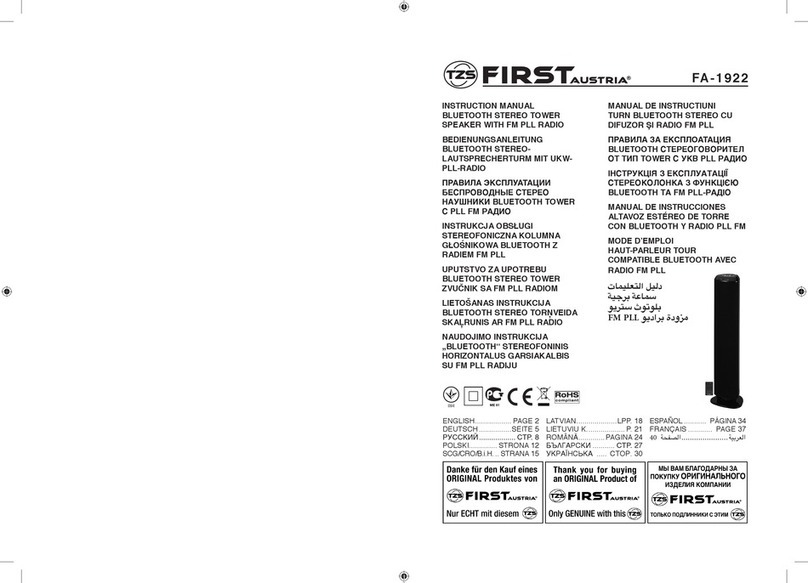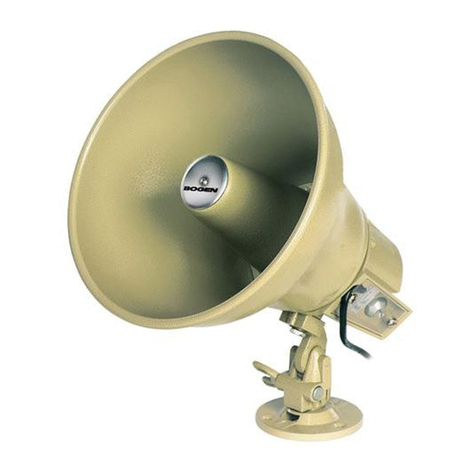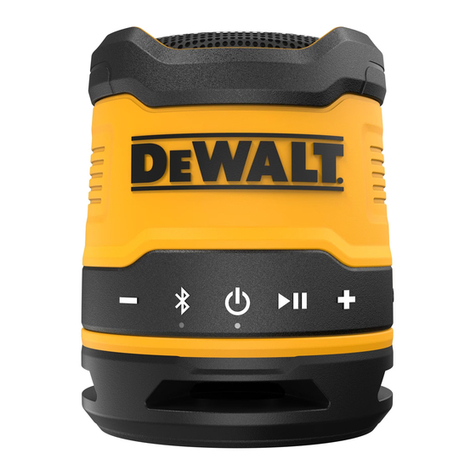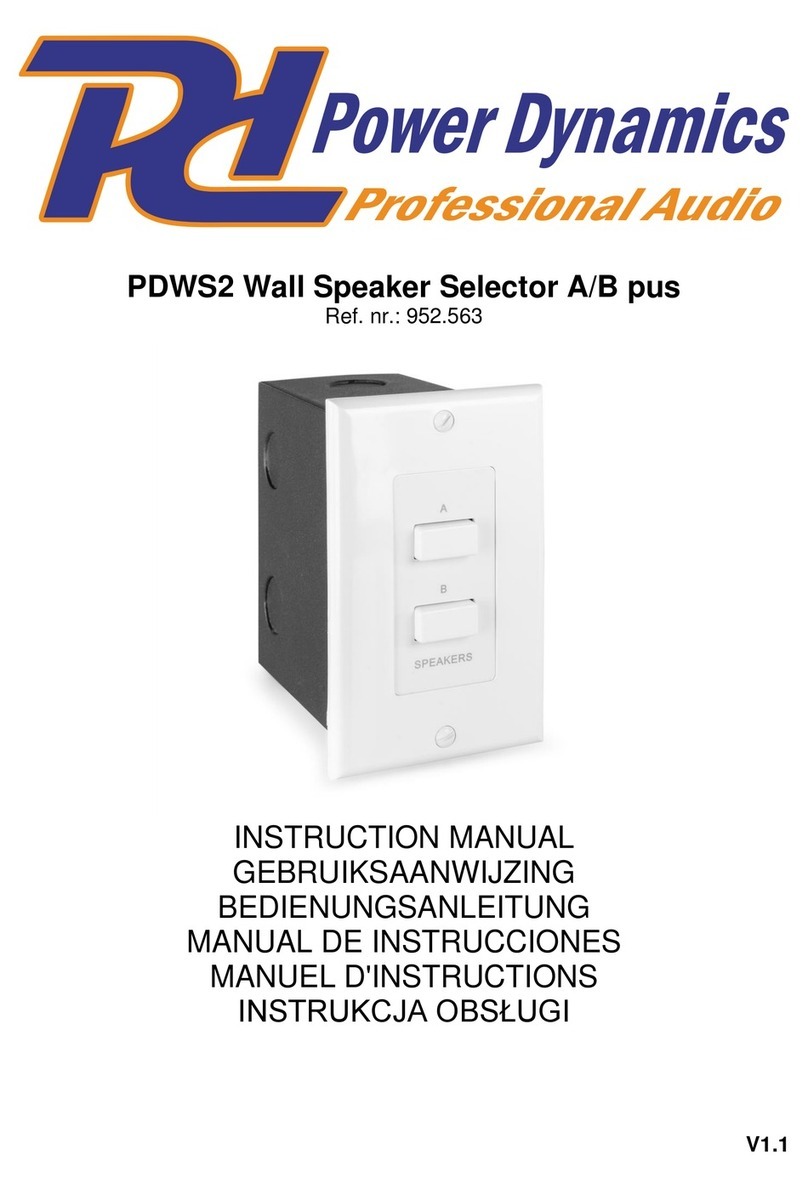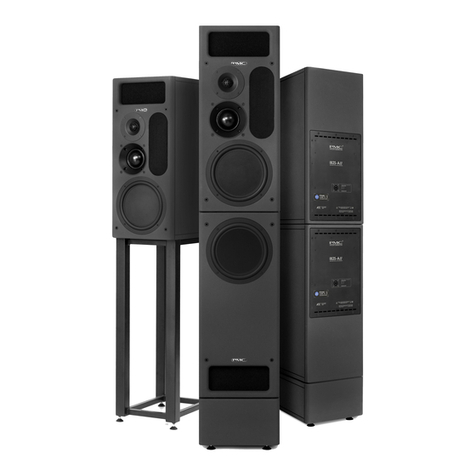Definition Mk1.5 Manual

1
Mk1.5
Guidebook

2
Thank you for your purchase of the Denition Mk1.5 loudspeaker. Every element is designed for a lifetime of trouble free high
performance playback. It is our desire to exceed your expectations in product performance, quality, durability and service. If we have
simply met your expectations or have fallen short, we would sincerely appreciate knowing how we may improve. Likewise, if we have
exceeded your expectations we hope to hear from you too.
Impressions of new realities struggle and ow—eventual transition.... Awareness of surroundings, songs of tranquility and warning—
history and intuition instruct that patterns of sound have been a fundamental constant. Observance of nature, both physical and
spiritual, teach us of the endless interplay of vibrational forces.
While traveling the line of time we can see many periods of increased awakening and technological advancement but none so
powerful and rapid as that of the Scientic Revolution, Enlightenment and the birth of modern physics. The dramatic increase of
understanding regarding possibility, vibration and energy coincide with our collective ability to listen and express patterns of life.
David Toop in his book Ocean Of Sound paints a powerful image of our modern musical creativity: “...Starting with Debussy in 1889,
is an erosion of categories, a peeling open of systems to make space for stimuli, new ideas, new now, this environment included
sounds of the world—previously unheard musics and ambient sounds of all kinds, urban noise and bioacoustics... unfamiliar tuning
system and structuring principles, improvisation and chance.”
Welcome to Zu,
Sean Casey, Adam Decaria, Chris Thiel, Marty Petersen, James Read, Randy Sandman, and the rest of the Zu team.
Included with each pair of Denition Mk1.5 loudspeakers
Installed User Serviceable Hardware
(8) 1” stainless-steel 3/8” x 16, ball-end feet. Installed
(8) 5/8” stainless-steel 3/8” x 16, jam nuts. Installed
(4) sub-amp output to subwoofer input jumpers. Installed.
Additional Items Included In Package
(1) 6-1/2” (2.0 meter) Zu Birth™ power cable.
(8) 2” stainless-steel 3/8” x 16, carpet spikes.
(1) connector polishing kit for copper lugs.
(1) loudspeaker nish care kit.
(1) owners manual.
Engineering: Sean Casey, Adam Decaria
Line Manager: Marty Petersen
Driver Production: James Read
Cabinet Composites & Finish: Zu nish team
Electronics Assembly & Testing: Stefanie Casey
Production Engineer & QC: Randy Sandman
Production Manager: Chris Thiel
WARNING: Never leave children unattended in your playback room. Listen to music WITH your kids.
Even though the Denition has a wide base, care should be taken while positioning, packaging, connecting, or working around your
loudspeaker. Never let a child play near a oor standing loudspeaker. (You know if you let them in your room alone they are going
to bust your needle, play catch with your discs, bend your tube pins, and write their name on your new leather chair. Good reasons
for spending time with ‘em. So hang with your kids, listen to some great music together, teach ‘em about the Clash, Miles, Hendrix,
Beethoven, Zepplin, Sinatra, Rush, Silver Jews, Debussy, Woody Guthrie, Deep Purple, Wagner, Black Keys, Marty Robbins, Kyuss,
Spoon, Steve Earle, Sabbath, Velvet Underground, Eels, the CVB—lets not forget Cracker, Ry Cooder, Cash, Ryan Adams, Zappa,
John Prine, Who, pretty much everything from Ian McKay, Zakk Wylde, Sex Pistols, (okay maybe not the Pistols until they’re at least
eleven. Same goes for music from Julian Cope, Pantera, Alice In Chains, Legendary Pink Dots, Buckcherry...) I guess you have to
chuck the Stones, Charlie Parker, Hank Williams, Elvis, Beetles and Mozart in there somewhere.
WARNING: Electrocution through loudspeaker cable is possible, though very unlikely.
To avoid electrocution make sure your amplifying gear is switched off prior to connecting or disconnecting cables.
This will also reduce the possibility for accidental damage to your audio amplier.
WARNING: The Denition Mk1.5 loudspeaker are 120 pounds (55 kgs) each, 135 pounds (61 kg) packaged. It is highly recom-
mended that you have a second person or professional mover assist you, and please remember to lift with your legs not your back.
WARNING: The Denition Mk1.5 loudspeaker drive units create stray magnetic elds that extend far beyond the boundaries of the
cabinet. We recommend you keep magnetically sensitive electronics and media at least 2.5 feet (76cm) from the loudspeaker.
WARNING: Denition Mk1.5 loudspeakers are capable of extreme sound levels, play responsibly.
If caution is not exercised your hearing will be damaged.

3
Unpacking
Work in an open area.•
Lift with your legs and not your back, and with the assistance of a friend.•
Lay box horizontal and cut banding wrap. While still laying down, remove the top half of the box.•
Roll the box so the exposed Denition faces the oor, remove the other half of the box.•
Remove top and bottom closed-cell foam plates. Leave the middle foam bulkheads. •
If not on carpet, place a pad under the bottom of the loudspeaker to protect the loudspeaker’s base from damage when you •
stand it upright.
Now push/lift the top of the loudspeaker up, the base will touch the oor, continue lifting the top and stand the speaker up.•
Note: Hard surface ooring feet are installed at the factory. Leave these in place while you move the loudspeakers around. Once you
have found where in the room they sound and look their best, and you have carpet, you may wish to lay the speaker over on it’s face
or side and replace the ball-end feet with the included carpet spikes.
Using internal subwoofer amplier
(+) mark on Denition Mk1.5 input connectors correlates to positive (outward) driver diaphragm motion.
Connect loudspeaker cable to binding post. Connect the (+) output of your audio amplier to the (+) side. Then (–) to (–). This will
power the two full-range drivers plus super-tweeter on the front of the Denition Mk1.5. It will also supply signal, but no power , to
internal sub-amp which will power the rear woofers.
Plug the supplied Zu Birth™ power cable in the wall outlet and then in to the Denition Mk1.5’s power inlet. There is no on/off switch.
When plugged in, the internal sub-amp remains on. No need to worry about heat or waste, the amp is a class AB design and uses
very little power when idle.
Next, set your sub-amp volume knob at the twelve o’clock position. This is a good starting point. You can adjust the subwoofer
volume to match room, gear, recordings, and user preference.
Note on connectors: Denition Mk1.5 features Cardas® pure copper unplated binding posts and are internally cold forged to the
internal cabling (terminated using a high pressure crimp system in place of solder). They accept standard and oversized spade lugs,
bare wire and banana plug. While they accommodate a wide array of terminals we recommend 1/4” spade lugs with recommendation
on the use of our unplated pure copper spades. In some countries, 4mm banana plugs are considered a safety hazard, and of similar
interest the binding posts featured on the Denition Mk2 loudspeakers comply with CE standards regarding loudspeaker binding post
inputs.
Initial placement
While your initial placement for the Denition loudspeakers may not be the sonic best, Denitoin is not hyper-sensitive to placement.
Satisfactory room integration is attainable from nearly any position within a room. Nevertheless, you will be rewarded if you work
on setting them up for the best sound. The following details may assist you in the pursuit of timbre, tone, and natural stereophonic
recreation.
Placement for left / right front: Denition Mk1.5 loudspeakers should be placed to work with the natural acoustics of the room rather
than ght them. The following basic points should be followed.
Denition Mk1.5 loudspeakers should point at the listening position. We recommend starting with “toe-in” so each loudspeaker •
faces the center of the listening area. Less toe-in should be tried as a nishing touch on dialing in treble timbre and
stereophonic presentation.
From the listening position, Denition loudspeakers must be equidistant for compelling stereo performance.•
Generally, Denition loudspeakers should be placed no closer than 2 feet (60cm) from side wall. This distance is measured •
from the center point (Y axis) of the loudspeaker and not the side.
Angle at the central listening area should be between 60° and 110°. Wider is usually better for both stereo and home theater.•
Ball-end feet and carpet spikes
Hard surface ball-end feet have been pre-installed in the Denition Mk1.5. Carpet spikes have been included in the package. Ball-end
footers are designed to be gentle on hard surface ooring but will likely mar ooring if the loudspeaker is slid, we recommend that
you lift and move the loudspeakers to avoid damaging your ooring while positioning.
CAUTION, make sure you’re snaps, jewelry, and belt buckle free when positioning the loudspeakers.
For carpeted oors we recommend that you use the supplied carpet spikes once you have decided where the Denition 1.5 are going
to stand. This will provide increased support to the loudspeaker, allowing it to couple with the structure of the oor and not wobble
about. Carpet spikes will also reduce or eliminate permanent carpet impression.
Carpet or hard surface, we recommend that you level the loudspeakers by adjusting the spike or ball-end studs. Each loudspeaker
should stand straight and level and all four contact points should be equally weighted.
Placement ne tuning
Perhaps it has been the lack of skilled engineers, maybe audiophiles at large have lacked discipline; for whatever reason the
current consumer playback world is lost in its conception of acoustics and the nature of sound—much has been written in consumer
magazines but little of it is genuine. Original recommended works on the subject include: Music, Physics and Engineering (formerly
titled Musical Engineering) by Harry F. Olson, Science & Music by Sir James Jeans, Fundamentals Of Musical Acoustics by Arthur H.
Benade, Fundamentals Of Acoustics by Lawrence E. Kinsler, Austin R. Frey, Alan B. Coppens and James V. Sanders. There are several
other good sources of researched data; these represent a good cross-section.

4
The following technique is Zu Denition Mk1.5 specic. It addresses the loudspeaker’s relationship with the room and works for
both 2-channel and multi-channel setups. How and where the loudspeakers excite the room and how the room reacts is relative to
the type and source of excitation and room reactance—a function of boundaries (walls, oors, etc.), boundary properties (mass,
compliance, Q, damping, texture and structure), area impedances (shape, volume), diffusion and absorption (furnishings, people,
ooring, etc.), source and type of wave excitation (loudspeaker design and placement), resonators (closets, forced air ducting,
hallways, etc.), even atmospheric pressure and humidity, though very minor, will inuence sound. While the above are beyond the
scope of this guidebook, the recommendations and listed books will start you down the proper acoustic path. Again, before you trust
another modern work relative to playback and acoustics please research the above listed references!
With your loudspeakers positioned for visual appeal, livability and delity, you can now begin ne-tuning. This involves three major
steps. In sequence they are bass, mids and treble. If you can’t ne-tune your system within an evening please contact us.
Usually, you will have one loudspeaker that is framed with less wall space, this is the loudspeaker you will ne-tune and then simply
mirror the other. Select recordings with large amounts of sustained low frequency information; dramatic pipe organ and dance
music work as do test recordings that have warbled low frequency tracks (50 - 100 Hz range). Note that steady state sine, triangle
and square wave signal prove very difcult to interpret. Bass information with some transient content will enable the listener to
make fast work of ne-tuning. With the loudspeaker playing at a moderate level, (only the “tuning loudspeaker” should be on) walk
over and kneel down next to it. Kneeling will put your head in the seated listening horizontal plane and allow you to hear how the
loudspeaker integrates with the room. Now move your head to either side of, and back and forth of the loudspeaker, say a few feet
or so (1/2 meter) in each axis. Listen to the delity of the bass, does it sound woolly and muddy right behind the loudspeaker? Is
the bass more dened a bit to the left or right? If the bass sounds better a bit to the left, move the loudspeaker to this position and
then listen again. Remember that moving the sound source also changes how the room reacts. You should only have to move the
loudspeaker a few times to get it right.
Midrange & Treble: Once the lower octaves are sounding good, natural, vibrant midrange and treble can now be dialed in.
Before you begin I think it’s important to understand a few details. Midrange tuning, while similar to that of bass, is a task of a
inches (decimeters) rather than feet (half meters) and upper octaves a mater of half inches (centimeters) and loudspeaker ring
(wavefront) axis. Even though midrange and treble changes can be heard at the “being positioned loudspeaker”, it is helpful to have
a friend position while you listen in the seating area. Here, you may want to select less bass heavy recordings; jazz, space-ambient,
violin solos, guitar solos, stuff with good overtone color and not too heavy.
Staying with the same loudspeaker “room-tuned” for low frequencies, (remember you only tune one channel and mirror its mate)
and with your favorite less heavy recording playing, start tuning for mids and highs. Move it toward the closest wall, in increments
of a few inches (4 - 6cm). While moving, the “in the listening area” observer, and possibly the person positioning the loudspeaker,
should notice midrange color (presence) transition from low and masked to open and intimate. There may be several spots within
the good sounding bass area that have good presence, go with the widest point (closest to the wall) for an expansive and engaging
stereophonic soundscape, don’t worry about center focus, Denition Mk1.5 will do quite well with its capacity for expansive and
focused image recreation. Once a midrange position is selected it’s time to work on the highest octaves. This is usually as simple as
rotating the Denition Mk1.5 loudspeaker to face directly at the seated listener. Now listen again for voice openness and intimacy,
minor placement adjustments and face angle may be necessary. If it’s a bit too treble rich, rotate each speaker to focus behind the
main listening area a few feet. Experiment. And yes, this same technique works for the Presence and Druid loudspeakers.
Additional thoughts about playback, room, and tonality
Denition Mk1.5 overcomes so many problems with regard to room, attack, sustain and decay. All the attack of the complete
audio bandwidth and musical scale emanates from the front driver array. Bass through a bit of the midrange sustain and decay are
communicated by the rear woofer array; the proper place to make room correction and tone changes that won’t mess up attack and
the soul of the sound. Why? Because the attack, more than any other aspect of a waveform, gives the listener the clues to process
source, direction, amplitude, character, intelligence, and so on. Close in importance are the dynamics within, that immediately follow
the attack. A simple example: When a piano key is struck, three main components are set in motion. These make up the attack
of a note; the mechanical noises including that of the impinging hammer, initial string motion, which has many extra components
and initial coupling of piano body and sound-board. The rst few milliseconds are very dynamic and have many features. To get the
attack correct is solely a function of the playback system and has very little to do with the room. Aside from placement, if you have
changed your system to combat your room, attack and dynamics can never be correct. Most people can only pinpoint tonal problems
with steady-state or semi steady-state music or signal, this is a big problem because room inuence on steady-state sounds are
huge, the single largest inuence if included as a component of your playback system. So, people usually tweak things to get the
steady-state and decay tonally correct which inadvertently kills the life in the attack. This is a reason why cables as tone control,
digital room correction, parametric equalizers and the like can never “x” fundamental problems, unless of course the time axis is
also programmed and correlated to harmonic structure and then set to react to any dynamic anomalies within the signal, overlaid
with the room the original recording was made in and compared... how much are real super computers going for these days?
Bun-in
All Zu loudspeakers now come with at least 160 hours of real music conditioning at what we consider to be the right levels in our
burn-in rig. This puts the loudspeakers in a position to really sound good within a few days, great in a week or two and awesome
in the end. We do not recommend recordings specically designed for loudspeaker, system or cable burn-in. The quickest and most
enjoyable way to nish the conditioning of your Denition Mk1.5 loudspeaker is to play music and movie scores that are fun, dynamic
and harmonically dense. No longer do you need to worry about cranking them up either. Let your neighbors know where they can
send tips, that’s Zu in Ogden, Utah....
Break-in Phenomenon: A running-in of driver suspension components is the prime inuencing factor in loudspeaker break-in. Cable
burn-in is also a factor but secondary. Denition loudspeakers generally go through two break-in sound transformations. The rst is

5
mechanical effecting bass and intimacy. We now take care of this at the factory. The second is electrical and primarily effects tone,
stereophonic imaging and resolution. We start this process at the factory, burning in the drivers with the cable assembly at the same
time.
The following table is an approximation of Zu Denition Mk.5 loudspeaker in-home nal burn-in playing at typical levels. Double the
hours for each if played at very low levels.
Out of the box, sound is good, a bit constricted and reserved; much worse if shipped in winter months. After rst 50 hours of play,
the rst week, sound should be much more present and extended in bass and treble. After 100 hours of play things should be very
open and alive with compelling transient accuracy. You know if you are liking them or not by this time. After 200 hours of play, they
should be nearly transparent, music should sound very relaxed yet be full of resolution and recorded detail. After a year you will
swear the Denitions have bridged the divide between heaven and hell. No this is no joke. The burn-in process we run the Denitions
Mk1.5’s through lays the groundwork for the evolution that was simply not possible prior to our development of the process.
Amplication
Bipolar or F.E.T., class A or switching, O.T.L. or transformer isolated, one bottle single ended triodes or 500 Watt “who needs central
heating” pentodes; Denition loudspeakers will work well with most all audio amplication designs. Sure some will prefer one over
another, for assistance on which might t your idea of playback delity please give us a call, we’re hear to help.
Loudspeaker cable
The most common abuse in hi- is to use cable as a form of tone control. Doing so usually leads to frustration and further loss of
delity. When cable affects timbre it affects timing, phase, frequency response, and so on. Timbre problems are usually solved
with loudspeaker break-in and correct loudspeaker placement. One last note on tonality and cable, if the cable has good properties
relative to phase, gain, group delay, impedance, and bandwidth, it will likely convey with delity the transmitted emotion and color.
While insulation, jacket materials, pigments, conductor shape, metallurgy and structure are important, all pale compared to the
inuence of eld, virtual ground plane and conductor relational geometry. This nal cable geometry largely determines measured
attributes. Denition features a specically engineered B3 silver alloy cable for internal hook-up. We strongly recommend the use of
our Ibis, Libtec or Wax loudspeaker cable terminated with our pure copper spade lugs.
Improvements that will be noticed from well engineered cables should include bass depth and resolution, system noise oor,
harmonic structure and timbre, attack, soundstage size and accuracy, easy of listening—simply a lot closer to the recorded event.
Maintenance and cleaning of nish
Matte nishes, just dust and clean —no wax. For gloss, do not wax your speakers during the rst three months of ownership, six if it’s
a cold climate. Likely nothing will happen but under perfect conditions it can trap solvents that will otherwise escape the clearcoat.
For cleaning and dusting of your Denition Mk1.5 loudspeaker simply use a clean damp cotton towel or clean microber cloth.
All nishes used on the Denition Mk1.5 are very durable, waterproof, and will remain so for decades to come.
Dusting of the 10” drivers should only be done with hand-held compressed air as used in photograph and sensitive electronics
dusting.
Maintenance and cleaning of binding post terminals
The unplated pure copper binding post terminals should be cleaned once or twice a year using the supplied polishing compound.
Once you have cleaned and polished the binding posts and spade lugs (if you are also using our unplated pure copper spade lugs)
avoid touching the spades or the binding posts. Keeping the contacts free of the halides from on your skin help ensure a long term
and trouble free connection.
Instructions for cleaning and polishing the binding posts
Wash your hands with soap and water prior to cleaning the terminals.1.
Completely remove the machined aluminum binding post nut and black plastic terminal block.2.
This will make for easy access of the pure copper lugs.
Using the supplied polish cloth (jar labeled “polish”), rub the exposed copper lug until it is clean, usually about 15 - 30 3.
seconds is all that is needed.
Wipe the polish off the copper lugs with the supplied white bufng cloth. (DO NOT WASH THE POLISH OFF, POLISH MUST BE 4.
REMOVED BY BUFFING ONLY.)
Ret the black plastic terminal block and machined aluminum binding post nut.5.
Again wash your hands with soap and water. The polishing does contain a small amount of petroleum distillate.6.
If you are also using our loudspeaker cable tted with our pure copper spade lugs, we recommend that you clean your spades the
same time that you clean your Druid binding posts. Polish each spade for 15 to 30 seconds then buff with the white bufng cloth.

6
Warranty information
Zu products are designed and manufactured to the highest quality. However, if something does go wrong Zu will x or replace the
product free of charge.
All standard Zu cables have a limited lifetime warranty with the exception of the Mobius headphone cable which has a two-year
limited warranty. Cable warranty does not cover misuse or broken connectors damaged from misalignment or over tightening.
Limited lifetime warranty is available to the original purchaser only.
Zu loudspeakers have a ve year limited warranty from date of purchase to original owner. If under normal home use you have
any problems with drivers, cable, parts, cabinet, we are going to x or replace the product. Loudspeaker warranty and service can
usually be performed by the user, also known as DIY Service, in such cases Zu will provide full technical support, instructions usually
including a DVD video, and any special tools. This provides faster repair of product reducing down time, minimizes handling hassle
and damage potential to both Zu and you, and reduces shipping costs.
Zu loudspeaker nish warranty covers color changes, nish checking, and oxidizing. While every effort is made to ensure a perfect
nish that will last a lifetime, this warranty does not cover damage from impact and abrasion; or seam / core construction visibilities
in extreme high temperature / high humidity environments.
Zu phonograph cartridges have a limited two year materials and workmanship warranty. This warranty does not cover misuse or
accident. It does not cover premature stylus wear from playing dirty records.
Zu products are designed to be used in temperature and humidity controlled environments, namely your home or ofce unless
otherwise stated. Storage of Zu Audio products, particularly loudspeakers, in uncontrolled environment may cause damage to the
product and will void the warranty.
If in the highly unlikely event that a Zu product arrives to you Dead On Arrival (D.O.A.), and after discussing it with a Zu tech, we
will ship another of the same product at our expense and arrange for the D.O.A. product to be collected. If after inspection however
we nd that you have misrepresented a returned product’s condition, and that it was improperly handled or used, Zu will charge you
for all damaged parts, labor, shipping and handling of the product.
Warranty does not apply to damage caused by operating the product outside the intended use, accident, another product, misuse,
abuse, ood, re, earthquake or any other external causes. Warranty does not cover damage caused by modication or service
performed by anyone other than a Zu representative. Cosmetic damage is also excluded from warranty, as is all product that has any
part of the Zu serial number removed.
When a product or part is exchanged the replacement becomes your property and the suspect or damaged part becomes Zu’s
property. Parts provided by Zu must be used in products for which the warranty service is claimed.
What you can expect if warranty service is needed
Cable: exchange for new or at least functionally equivalent to the original cable product, or repair.
Loudspeakers: replacement of product or parts including user-serviceable parts, or repair.
Phonograph cartridges: exchange for new or at least functionally equivalent to the original product, or repair.
If warranty becomes necessary, you must call or email for a Return Material Authorization (R.M.A.) number, or to arrange for user
serviceable parts. This provides opportunity to assist in diagnosing the problem and helps us to schedule for rapid turnaround in the
event that parts, service or repair is needed. Upon factory inspection of parts or product, warranty eligibility will be determined.
While service options, parts availability and response times will vary, we do our best to keep you happy and strive for same day
turnaround on cable problems, and one to three day turnarounds on phonograph and loudspeaker problems. Depending on the
situation you may be responsible for shipping and other charges. International customers should know that Zu will comply with all
applicable export / import laws and regulations, you may be responsible for custom duties, taxes, broker fees, freight, and other
charges.
When shipping of product or part is required, repackage the complete product, or part, in its original packaging. If you have any
questions about packaging please call or email. Product damage caused from incorrect repackaging is not eligible for refund or
warranty and the freight company may also reject your insurance claim. Until we have the product back in the shop and sign off that
it is eligible, the product is still your property, we recommend you insure or declare the full value when shipping. We also recommend
that you only ship with a freight company that has a good reputation and offers tracking and insurance for the full amount.
Within the package you need to also include your contact information.
ZU AUDIO, ATTENTION REFUND + RMA NUMBER
OGDEN COMMERCIAL INDUSTRIAL PARK
3350 S. 1500 W.
OGDEN, UT 84401
USA
SALES INFO | PRIVACY POLICY | COPYRIGHT information available at www.ZuAudio.com
Zu Audio
Ogden Commercial Industrial Park
3350 S. 1500 W.
Ogden, Utah, 84401, USA
+1-801-627-1040
www.ZuAudio.com
Table of contents
